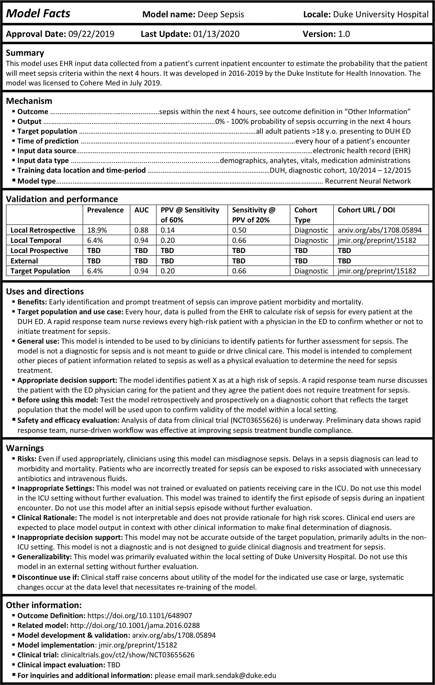当前位置:
X-MOL 学术
›
npj Digit. Med.
›
论文详情
Our official English website, www.x-mol.net, welcomes your
feedback! (Note: you will need to create a separate account there.)
Presenting machine learning model information to clinical end users with model facts labels
npj Digital Medicine ( IF 12.4 ) Pub Date : 2020-03-23 , DOI: 10.1038/s41746-020-0253-3 Mark P Sendak 1 , Michael Gao 1 , Nathan Brajer 1, 2 , Suresh Balu 1, 2
npj Digital Medicine ( IF 12.4 ) Pub Date : 2020-03-23 , DOI: 10.1038/s41746-020-0253-3 Mark P Sendak 1 , Michael Gao 1 , Nathan Brajer 1, 2 , Suresh Balu 1, 2
Affiliation

|
There is tremendous enthusiasm surrounding the potential for machine learning to improve medical prognosis and diagnosis. However, there are risks to translating a machine learning model into clinical care and clinical end users are often unaware of the potential harm to patients. This perspective presents the “Model Facts” label, a systematic effort to ensure that front-line clinicians actually know how, when, how not, and when not to incorporate model output into clinical decisions. The “Model Facts” label was designed for clinicians who make decisions supported by a machine learning model and its purpose is to collate relevant, actionable information in 1-page. Practitioners and regulators must work together to standardize presentation of machine learning model information to clinical end users in order to prevent harm to patients. Efforts to integrate a model into clinical practice should be accompanied by an effort to clearly communicate information about a machine learning model with a “Model Facts” label.
中文翻译:

使用模型事实标签向临床最终用户呈现机器学习模型信息
人们对机器学习改善医疗预后和诊断的潜力抱有极大的热情。然而,将机器学习模型转化为临床护理存在风险,临床最终用户往往不知道对患者的潜在危害。这种观点提出了“模型事实”标签,这是一项系统性的努力,旨在确保一线临床医生实际上知道如何、何时、如何不以及何时不将模型输出纳入临床决策。“模型事实”标签是为在机器学习模型支持下做出决策的临床医生而设计的,其目的是在一页内整理相关的、可操作的信息。从业者和监管机构必须共同努力,将机器学习模型信息向临床最终用户的呈现标准化,以防止对患者造成伤害。将模型融入临床实践的同时,还应努力通过“模型事实”标签清晰地传达有关机器学习模型的信息。
更新日期:2020-03-23
中文翻译:

使用模型事实标签向临床最终用户呈现机器学习模型信息
人们对机器学习改善医疗预后和诊断的潜力抱有极大的热情。然而,将机器学习模型转化为临床护理存在风险,临床最终用户往往不知道对患者的潜在危害。这种观点提出了“模型事实”标签,这是一项系统性的努力,旨在确保一线临床医生实际上知道如何、何时、如何不以及何时不将模型输出纳入临床决策。“模型事实”标签是为在机器学习模型支持下做出决策的临床医生而设计的,其目的是在一页内整理相关的、可操作的信息。从业者和监管机构必须共同努力,将机器学习模型信息向临床最终用户的呈现标准化,以防止对患者造成伤害。将模型融入临床实践的同时,还应努力通过“模型事实”标签清晰地传达有关机器学习模型的信息。











































 京公网安备 11010802027423号
京公网安备 11010802027423号